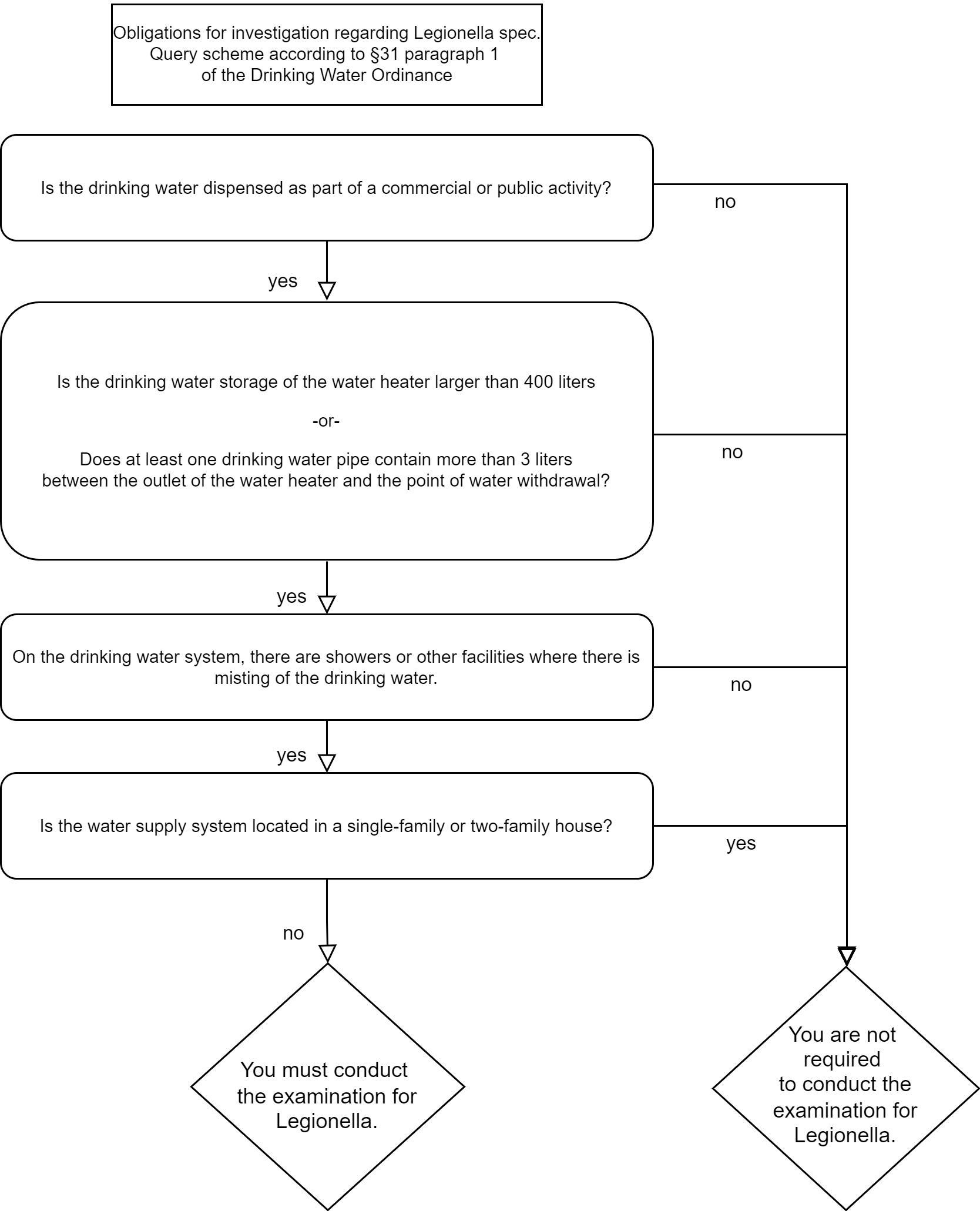Legionella
- Systemic testing of drinking water installations for Legionella according to §31 of the German Drinking Water Ordinance -
Legionellae are bacteria that occur in drinking water and can cause severe pneumonia. They cannot be transmitted from person to person, but only by inhaling contaminated water mist. Legionella bacteria multiply mainly at temperatures between 25 and 55 °C in water pipes, shower heads, air conditioning systems or whirlpools. The symptoms of a Legionella infection are fever, cough, shortness of breath, headaches, and aching limbs. Legionellosis is a notifiable disease.
To minimize the risk of Legionella infection for users, the systemic testing required by the Drinking Water Ordinance must be carried out regularly. The following measures should be taken at the same time:
- The hot water temperature at the water storage tank should be at least 60°C to inhibit the growth of the bacteria.
- The cold-water temperature should be below 25°C to prevent the bacteria from multiplying. Flush the furthest tapping points with cold water until the so-called supply quality is reached.
- The water pipes should be regularly flushed and maintained, dead pipes (e.g. unused showers or washbasins) should be removed if possible.
- The water quality should be checked and analysed regularly to determine the legionella content.
Legionella in drinking water is a serious health problem that must not be ignored. By following the above measures, the risk of infection can be reduced, and consumer safety ensured.
Responsibility
Testing for legionella is a legal requirement for all drinking water systems that meet certain criteria. This includes, for example, systems with more than 400 liters of storage volume or more than three liters of pipe volume between the outlet of the storage tank and the furthest tapping point.
The responsibility for testing lies with the operators of the systems. For example, the landlords or owners of residential or commercial properties.
Inspection intervals
- Drinking water that is supplied as part of a commercial activity must be tested every three years. (e.g. rented apartment, fitness studio, campsite)
- Drinking water that is supplied as part of a public activity must be tested annually (sports facility, school, daycare center, retirement, and care facility)
The frequency of testing depends on the type of facility and the group of users. In accordance with the Drinking Water Ordinance §31 Paragraph 2, building supply systems where drinking water is supplied as part of a commercial activity, but not as part of a public activity, must be inspected every 3 years.
All other properties with building water supply systems, including that where drinking water is supplied as part of a public activity, must be inspected at least once a year. To ensure compliance with Section 23(5) of the Infection Protection Act, facilities such as care facilities and others housing patients at higher risk of Legionella spec. infection must undergo annual inspections of their water supply systems.
In the case of a newly commissioned water supply system, the first test for the Legionella parameter must be carried out within three to 12 months of commissioning.
In the case of mobile water supply systems and temporary water supply systems, the frequency of testing is determined by the public health department.
Procedure when the technical measure value is reached
- immediate information to the public health department
- immediate information to the users by means of a notice or letter
- further investigation to determine the extent of the contamination
- site inspection, risk assessment (hazard analysis), determination of measures
- subsequent follow-up investigation
If the specified technical action value for the parameter Legionella spec. of 100 cfu/100 ml is reached in a drinking water installation, the operator of the water supply system in which the drinking water installation is located must notify the public health department immediately, unless he has proof that the notification in accordance with Section 53 (1) has already been made by the approved testing body.
Subsequently, investigations must be carried out to clarify the causes. These investigations include a site inspection and an examination of compliance with the generally recognized rules of technology in the affected drinking water installation. A written risk assessment must be prepared in accordance with the Federal Environment Agency’s recommendation “Recommendations for carrying out a risk analysis in accordance with the Drinking Water Ordinance – Measures if the technical action value for legionella is exceeded” from December 2012 (Bundesgesundheitsblatt 2023 p. 188). Considering the recommendation of the Federal Environment Agency mentioned in number 3, the measures required to protect the health of consumers in accordance with the generally recognized rules of technology must be carried out.
In the risk assessment, hazards to human health and events or situations that may lead to the occurrence of a hazard to human health from the water supply system concerned must be systematically identified and evaluated. In addition to this identification and evaluation, the risk assessment must include at least the following.
- description of the water supply system
- observations made during the site visit
- deviations from the generally recognized rules of technology identified
- other findings on the water quality, the water supply system, and its use
- results of tests for the parameter Legionella spec. including details of the sampling points in the drinking water installation, stating the date and time of sampling.
The operator must inform the public health department immediately of the measures taken in accordance with paragraph. At the request of the public health department, the risk assessment must be submitted without delay.
Would you like expert advice?
We are at your disposal for individual, precise and quality-oriented advice.
Contact us for further information.


